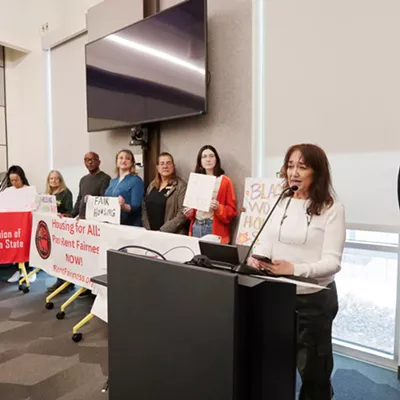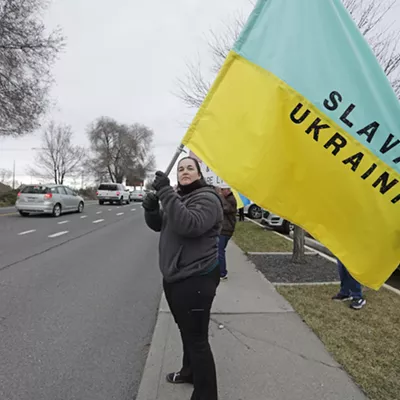
In a windowless lab in Olympia, Washington state's physical anthropologist, Guy Tasa, is surrounded by old bones. A major part of his job within the Department of Archaeology and Historical Preservation is to analyze skeletal remains not related to any active death investigation.
Tasa says his office gets a new case about every four or five business days, a total of about 50 to 60 cases per year. Last year, that included a single, tan colored skull that had been turned over to the Spokane County Medical Examiner's Office.
Generally, once a medical examiner or coroner determines the remains are not related to a death investigation, Tasa takes over.
In the case of this particular skull, Tasa uses only measurements of the skull's dimensions and facial features to determine that it belonged to a woman, who would have been between 40 and 50 years old at the time she died. Those measurements also indicated that she was Native American, which touched off a notification to tribes in the area.
"These features are subtle and require years of experience in seeing and evaluating a variety of skeletal remains," says Tasa, whose analysis does not include any tests that would destroy pieces of the bones, such as carbon dating or DNA analysis.
Ultimately, the Spokane Tribe of Indians retrieved the skull and reburied it in a private ceremony. Even the tribal chairwoman, Carol Evans, isn't privy to the skull's reburial location.
"The return of remains to the tribe is a sacred event," Evans says. "These are the remains of our ancestors that have been disturbed, so we need to take care of that and do so in a respectful manner. We even hide them from ourselves, in a sense."
The process of repatriating tribal remains is spelled out in Washington state law and is one indicator of a shift in deference to tribal customs over scientific research in the past decade.
"Washington state has some of the strongest cultural resource laws in the nation," says Allyson Brooks, the state Historic Preservation Officer. "The state has always taken a different tone between archaeology and tribes than other parts of the United States."
Specifically, Brooks points to one highly publicized legal battle between a group of scientists and five Native American tribes over rights to one of the oldest, nearly complete skeletons found in North America, known as the Ancient One, or Kennewick Man.
In 1996, two college students spotted a skull on the banks of the Columbia River near Kennewick, Washington. They turned the skull over to officials, who soon unearthed a nearly complete skeleton, some 350 pieces. Researchers soon learned the bones were about 8,500 years old.
The U.S. Army Corps of Engineers, which manages the land where Kennewick Man's bones were found, initially intended to repatriate the remains to a tribal nation that sought to rebury them. Under the federal Native American Graves Protection and Repatriation Act, tribes with a proven connection to certain remains and artifacts are entitled to have them returned.
"If you lose a mother, and you bury them in cemetery and your neighbor digs them up and displays them in their house next door, how would you feel?" ~ Carol Evans, Spokane Tribe of Indians chair
But then a group of scientists stepped in and filed a lawsuit to stop the reburial. They saw the bones as a potential gold mine of information about how early humans came to North America and how they lived. Thus began a legal dispute that pitted scientific research against respect for tribal traditions.Based in part on the size and shape of Kennewick Man's skull, an early analysis, similar to the one Tasa performs today, suggested the man was related to the Ainu, a group of people from northern Japan.
By 2005, federal judges ruled that the tribes showed no evidence of a connection to the bones, and a team of scientists led by Douglas Owsley, a forensic anthropologist with the Smithsonian Institution, was clear to begin gathering data. They eventually published a 670-page book.
But in 2015, scientists revealed that Kennewick Man's DNA was in fact "closer to modern Native Americans than to any other population worldwide."
In 2017, with help from the Washington State Department of Archaeology and Historic Preservation, Kennewick Man's bones were returned to the tribes and reburied in an undisclosed location.
Throughout and since the Kennewick Man legal fight, scientists and tribal nations have butted heads over ancient remains in the West. The bones of an infant boy found on private land in Montana in 1968 were only reburied in 2014, after scientists had sequenced his entire genome.
In 2016, the legal battle over two skeletons discovered in the San Diego community of La Jolla by University of California students in 1976 finally ended in a victory for tribal nations. A molecular anthropologist at Washington State University, Brian Kemp, who filed a brief with the U.S. Supreme Court supporting the scientific study of the remains, lamented the lost opportunities to learn more about ancient North America.
"Ancient human remains like the La Jolla remains are an indispensable component to comprehending human history because they provide the most direct and intimate access to our ancestors," Kemp argues in court documents. "Without scientific studies of ancient humans and human ancestors, we would have a very limited understanding of how we came to be who we are as a people."
Since Tasa's position as Washington's resident bone expert was created in 2008, he has handled at least 486 cases, according to a report submitted to the state Legislature last year.
In each case, Tasa uses calipers to measure the skeletal remains and determine whether they're likely ancestors of Native Americans. For this work, skulls are particularly revealing. Specifically, Tasa says, higher cheekbones that project forward are strong indications that the remains are Native American. Other features, such as the size and shape of the eyes and nose, also factor in.
He then enters the numbers into a database to help him make a determination. Tasa can also consider the context in which the remains are found, such as the location and whether any artifacts are found nearby. About 80 percent of the remains he analyzes belong to Native Americans, he says.
For the tribes who take back the remains of their ancestors, the process is emotional.
"It's a way of respecting someone's right to know their loved one is in a special place," Evans, the Spokane Tribe chairwoman says. "If you lose a mother, and you bury them in cemetery and your neighbor digs them up and displays them in their house next door, how would you feel?" ♦
















